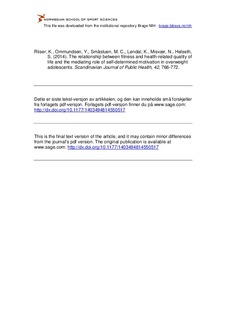| dc.contributor.author | Riiser, Kirsti | |
| dc.contributor.author | Ommundsen, Yngvar | |
| dc.contributor.author | Småstuen, Milada C. | |
| dc.contributor.author | Løndal, Knut | |
| dc.contributor.author | Misvær, Nina | |
| dc.contributor.author | Helseth, Sølvi | |
| dc.date.accessioned | 2016-02-02T10:34:49Z | |
| dc.date.available | 2016-02-02T10:34:49Z | |
| dc.date.issued | 2014-09-30 | |
| dc.identifier.citation | Scandinavian Journal of Public Health. 2014, 42, 766-772 | nb_NO |
| dc.identifier.uri | http://hdl.handle.net/11250/2375665 | |
| dc.description | I Brage finner du siste tekst-versjon av artikkelen, og den kan inneholde ubetydelige forskjeller fra forlagets pdf-versjon. Forlagets pdf-versjon finner du på http://sjp.sagepub.com/content/42/8/766 / In Brage you'll find the final text version of the article, and it may contain insignificant differences from the journal's pdf version. The definitive version is available at http://sjp.sagepub.com/content/42/8/766 | nb_NO |
| dc.description.abstract | Aim: To examine the relationship between cardiorespiratory fitness (CRF) and health-related quality of life (HRQoL) among overweight adolescents and to test whether this relationship is mediated by body image (BI) and self-determined motivation for physical activity (PA) and exercise. Methods: One hundred and twenty adolescents identified as overweight or obese were recruited through the school health service. The participants completed self-report instruments measuring HRQoL, BI and self-determined motivation for physical activity and exercise in addition to a 20 m shuttle-run test, and body mass index was calculated. Confirmatory factor analysis was conducted to evaluate the hypothesised five-dimensional structure of the Behavioural Regulation in Exercise Questionnaire-2 (BREQ-2) used to measure self-determined motivation. Associations between the study variables were explored using univariate linear regression. Mediation was tested by a multistage regression approach. Results: The five-dimensional model of BREQ-2 showed acceptable fit for the data. We revealed a statistically significant association between cardiorespiratory fitness and HRQoL (4.16 [0.3–8.02]; p < .05). CRF failed to affect BI in the first mediation equation. Hence, body image was excluded from further analyses. However, self-determined motivation proved to mediate the relationship between CRF and HRQoL. Conclusions: The results of this study suggest that the motivational mechanisms related to fitness can contribute to explain the association between CRF and HRQoL in overweight adolescents. The findings are important from a public health point of view and should be taken into account in the development of PA interventions for overweight and obese adolescents for the potential enhancement of their physical and psychosocial well-being. | nb_NO |
| dc.language.iso | eng | nb_NO |
| dc.publisher | Sage | nb_NO |
| dc.subject | adolescents | nb_NO |
| dc.subject | overweight | nb_NO |
| dc.subject | cardiorespiratory fitness | nb_NO |
| dc.subject | health-related quality of life | nb_NO |
| dc.subject | self-determined motivation | nb_NO |
| dc.title | The relationship between fitness and health-related quality of life and the mediating role of self-determined motivation in overweight adolescents | nb_NO |
| dc.type | Journal article | nb_NO |
| dc.type | Peer reviewed | nb_NO |
| dc.subject.nsi | VDP::Medical disciplines: 700 | nb_NO |
| dc.source.journal | Scandinavian Journal of Public Health | nb_NO |
| dc.description.localcode | Seksjon for coaching og psykologi / Department of Coaching and Psychology | nb_NO |
